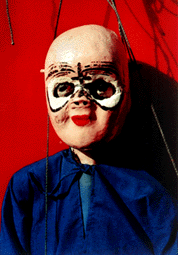Glove puppeteers are in fact three-in-one artists. They usually handle two puppets at a time and must divide their attention between the two while maintaining a level head and exhibiting the skill at their fingertips.
The famous puppet artist Yang Sheng is perhaps the most outstanding representative of glove puppet manipulators from Longxi. His magic hands seem able to speak, dance, and express the feeling of his characters.
He is most proficient in plays based on stories from Romance of the Three Kingdoms, Outlaws of the Marsh, and Chinese mythology, all of which consist mainly of battle scenes, with the emphasis on acrobatics. He can make his puppets do tricks such as puffing and blowing, contracting their necks, swinging their pigtails, and taking off their clothes. He made his name as an outstanding puppet artist for his play Jiang Gan Steals the Letter, an episode from Romance of the Three Kingdoms.
In addition, he has performed abroad, winning acclaim for his Lei Wanchun Fights the Tiger and Daming Prefecture.
Yang's excellent delineation of characters, songs in distinctivePeking operatunes, and superb manipulation can best represent the highest level of the glove puppetry of the Northem school in Fujian.
Longxi boasts several hundred plays on different subjects including traditional plays, modern plays, and plays for children. Longxi puppeteers have performed on four continents and won gold medals in the Second International Puppet Festival for their Lei Wanchun Fights With a Tiger and Daming Prefecture. Their representative works include Jiang Gan Steals the Letter, Marrying by Force, and Zheng Chenggong.
 String Puppets in Heyang, Shaanxi
String Puppets in Heyang, Shaanxi
 The string puppet show of Heyang in Shaanxi is one of the oldest genres of puppetry in China judging from the facts that its puppets closely resemble the figurines crafted during the Tang period and still retains the baldheaded clown which was characteristic of the puppet dating from the Northern Qi Dynasty in the sixth century.
The string puppet show of Heyang in Shaanxi is one of the oldest genres of puppetry in China judging from the facts that its puppets closely resemble the figurines crafted during the Tang period and still retains the baldheaded clown which was characteristic of the puppet dating from the Northern Qi Dynasty in the sixth century.
Heyang puppets are between 80-90 centimeters long. Older puppets are flat, with most lacking hands and feet. -A puppeteer usually controls a puppet via 5-7 strings (three attached to the head, two to the wrists, and one to the waist). The number of strings can be increased to 13 if required. In the past, strings used to control the puppet were about one meter long. However, with the introduction of the new stage in the 1970s, puppeteers began manipulating puppets from above and have since used much longer strings.
Over centuries of practice, Heyang puppeteers have developed eight techniques -- lifting, pulling, hooking, jerking, twisting, swinging, oscillating, and shaking -- for using both their hands and arms to manipulate the strings. They use these techniques to make their puppets dance and do many other movements closely resembling human beings.
